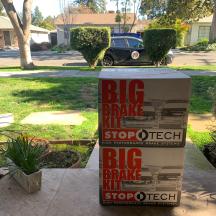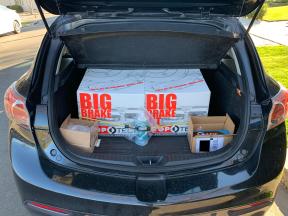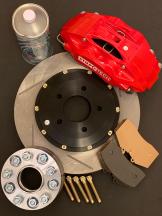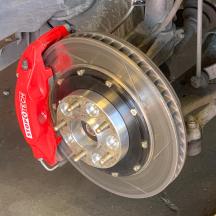Two months before this track day I learned that my Big Brake Kit (BBK) would not arrive until early April, a week too late. That led to the analysis below, though when two big boxes showed up on my doorstep in mid-February the exercise became moot. I'm leaving it here because it was interesting, at least to me.
In late January I learned that my Big Brake Kit (BBK) would not arrive until early April, a week after this track day. The Mazdaspeed 3's stock brakes are inadequate for track use, especially on a track that's as hard on brakes as Laguna Seca. After multiple attempts, I threw in the towel and ordered StopTech ST-40 brakes, something I should have just done from the start. (I can be stubborn about trying to make things work.)
After owning my Mazdaspeed for a year and wrestling with brake issues on the track, I upgraded to G-LOC R12 pads (front; R10 in back) and finally found confidence in the car's braking, first at Willow Springs and a few weeks later at Laguna Seca. With brake demons vanquished I was ready to consider some modest engine upgrades, good for an estimated 10-15% increase above the stock 263 horsepower. A few weeks after the upgrades, another visit to Laguna Seca incinerated the brake pads (photograph at left) and led to minimal lap-time improvements despite significantly faster speeds at Turn 1. Sigh.
For a November return to Laguna Seca I upgraded to G-LOC R16 pads and upgraded the brake fluid from Motul RBF 600 to RBF 660, affording a substantial increase in minimum boiling point from 312 C to 328 C. The result was pads that took the abuse admirably but the fluid boiled yet again. At least one wheel weight melted off, too.
Hacking the problem in lieu of a proper solution (the BBK) requires reducing the amount of braking needed (i.e., taking Turn 2 faster) or helping the brakes cope with greater energy. A long conversation with the ever-helpful Matt Davey at Damond Motorsports yielded a number of ideas:
Focusing on faster speeds in Turn 2, a key question is how much faster I need to take the turn. Last February, speeds for my best lap were 105.0 mph at Turn 1 braking to 41.0 mph for Turn 2. A 2013 Mazdaspeed 3 weighs 3,221 lbs so estimating a track weight of 3,500 lbs (driver and fuel, minus the spare tire, jack, etc.) the kinetic energy that was dissipated works out to about 1,480 kilojoules. The following graph shows the energy dissipation for various speeds at these two turns.
The green curve indicates ~1,480 kilojoules, which the stock brakes (using G-LOC R12 pads) were capable of handling. The green dot marks my February 2020 speeds. The red dot marks my best lap in August with the red curve showing the ~1,600 kilojoules energy dissipation which cooked my brakes. The line up to the green curve shows that to stay at the same braking energy as in February I would have needed to take Turn 2 at 49.1 mph. The orange dot is for November, with a green-curve energy speed through Turn 2 of 51.9 mph. My fastest time on Turn 2 was 44.5 mph last August, which implies a need to increase about 16.6%. That isn't completely unreasonable, though I need to improve consistency at hitting faster speeds.
Somewhere in grey area between the two curves lies the energy at which the brakes tip from survival (green) to getting cooked (red). It might be that the red curve was just barely beyond what the brakes could handle, and better brake fluid would expand the energy budget enough to survive, or maybe the green curve is at the ragged edge and I'll need to do just about everything to maxmize Turn 2 speed and avoid heat issues.
(This discussion assumes all of the energy is dissipated into the brakes, ignoring braking due to aerodynamic drag. That's probably a minor amount, and doesn't alter the speed analysis.)
Of course improvements that allow Turn 2 to be driven faster should also improve speeds in Turn 11, translating to higher speeds on the front straight and at Turn 1 before braking. Since the kinetic energy is proportional to the square of the velocity this could easily push the brakes back into "cooked" territory
Returning to Turn 2, the upgraded rear swaybar may be an important factor. I've been driving ths turn using what one friend calls a diamond line: overshoot the first apex, turn sharply, then use the car's power to drive a straighter exit line. This approach reduces understeer and front-wheel slip on the exit. If the new rear swaybar controls understeer enough to drive a conventional double-apex line the turn could be significantly faster.
Here is the proper solution, installed in late February—a StopTech ST-40 The Big Brake Kit (BBK), aka Stop-Stop for the Zoom-Zoom:

 |

 |
It's a very good thing that the BBK arrived as my experience at Buttonwillow suggested that my brake-survival plan would have failed. Here are the right front brake pads after that day, which was only their second time on the track after Laguna Seca last November:
|
Copyright © 2020-2021 Karl L. Swartz. All rights reserved. |

|